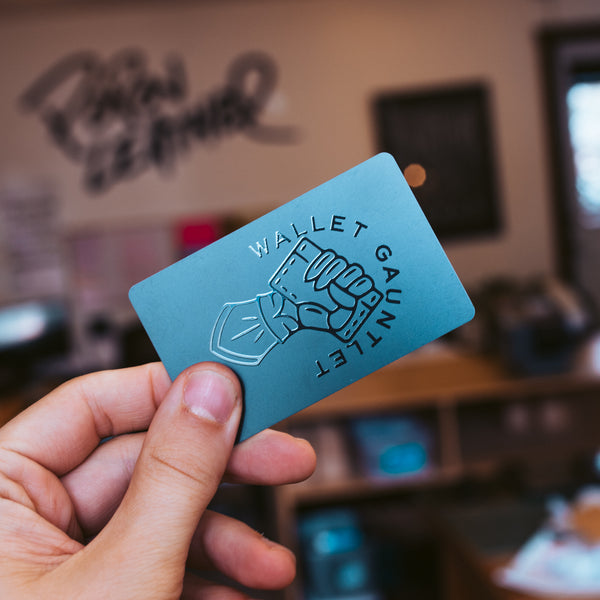RFID blocking cards exist to keep your most important information secure. There was a time when the biggest concern you had about losing your wallet was that it might be pickpocketed. Today, pickpocketing is a petty theft compared to the possibility of having your card’s information stolen from an RFID scanner. Today’s thieves don’t even need to touch you to steal your credit and debit card information; all they need to do is walk close to you with an RFID scanner. In fact, in the course of 20 minutes, a skilled RFID thief can gather card details from 50 cards just by walking through a busy street or shopping center.
These cards can prevent you from suffering credit card fraud and identity theft.
Table of Contents
- Does 2022 require RFID blocking?
- What is RFID?
- Can RFID be hacked?
- What does RFID crime look like in 2022?
- What is an RFID blocking card?
- How do RFID blocking cards work?
- How do you use an RFID blocking card?
- When should you use RFID blocking card protectors?
- How do you choose the best RFID blocking technology?
- Which is better, RFID blocking cards or sleeves?
- Can RFID cards be read through RFID blocking wallets?
- What kind of RFID blocking card should you get?
- What’s the best RFID blocking card on the market?
- How to test that your RFID Blocking card is working
- Protect against RFID crime with a top RFID blocking card
Does 2022 require RFID blocking?
Financial experts continue to debate the necessity of RFID blocking technology. Some experts say that there is no need for RFID blocking technology because most credit cards and debit cards are secured and you will likely be reimbursed for fraudulent activity on your cards. However, that reimbursement is usually time-limited, meaning that if you don’t notice the activity for more than sixty days, your financial institution is not required to reimburse you.
Additionally, it can take time for financial institutions to investigate reported credit card or debit card fraud. While that investigation is underway, those funds may be on hold. Considering the fact that six in ten Americans doesn’t have an extra $500 for an emergency, the idea of large chunks of money being out of your reach for periods of time can be a big deal for some families.
Finally, if your card information is stolen, you may need to wait for a new card to come in before you make purchases. While this is one reason we recommend cash as one of your key EDC everyday carry items, 50% of Americans report regularly not carrying cash with them when they leave the house. Add the inconvenience of not having cash in with the possibility of needing to switch information around for all of the institutions where you have autopay enabled, and it becomes clear that preventing your information from being stolen in the first place can save you a lot of frustration.
What is RFID?
RFID is an acronym that stands for Radio Frequency Identification. This technology is embedded in numerous devices, including credit cards, debit cards, passports, and contactless cards. Microchips allow this RFID technology to work at short ranges — typically a few inches. This is the idea behind having chip readers for credit cards, for example, or scanners for passports.
Can RFID be hacked?
Unfortunately, RFID technology can be hacked. Powerful RFID readers can collect RFID information from up to a meter away, while hackers can collect information from up to three meters away. This means that you could be in an airport, shopping center, or busy street and have your information stolen from someone who’s not even close enough to touch you.
Luckily, RFID skimming from these distances uses a relatively sophisticated technology. Most hackers who are capable of skimming RFID information from long distances are using their skills for something more complex. The greatest risk of your RFID information being stolen still comes from close-range skimmers.
What does RFID crime look like in 2022?
RFID skimming is one of the main RFID crimes in 2022. Essentially, RFID skimming works by a person coming near you with an RFID scanner and skimming the information off your RFID microchip. This video shows how easy and quick it is to use RFID-scanning technology to glean credit card information.
Most of the time, skimmers would need to be within a couple of inches of a credit card user to do this, but in crowded situations — like on a train or in an airport — this close proximity might not be noticed.
Fortunately, there is a limit to the information transmitted from your RFID microchip. For example, on credit cards, RFID chips include your card number and expiration date, but they don’t include the three security numbers on the back. This means that there’s at least a bit of a cap on what criminals can do with the information.
What is an RFID blocking card?
An RFID blocking card is a small card that you slip into your wallet next to your RFID-enabled card to prevent your information from being stolen.

How do RFID blocking cards work?
These cards are the size of typical credit cards, and they work in an active way. Instead of just blocking attempts to steal your information the way RFID blocking wallets do, RFID blocking cards actively scramble those attempts, jamming the scanner so hackers can’t try again.
How do you use an RFID blocking card?
Using an them is easy. Our wallet gauntlet provides constant security within 2cm on either side. This makes it the perfect everyday carry wallet accessor. All you have to do is slide it into your wallet next to your RFID-enabled credit card and you don’t have to worry about hackers or skimmers getting ahold of your personal information.
When should you use RFID blocking card protectors?
You never know when someone might try to steal your information. While RFID blocking card protectors are most important when you know you’re going to be in a crowded location — when you’re flying on a plane, for example, or taking the subway — their slim design makes it easy to incorporate them as an everyday carry item. When you’re used to having them in the same wallet sleeve as your credit card, it ensures you’ll have it when you need it.
How do you choose the best RFID blocking technology?
Numerous RFID-blocking products have been developed in response to the need to protect sensitive information. However, not all RFID-blocking technology is created equal.
There are two major types of RFID-blocking technology: passive blocking and active blocking.
Using a passive RFID blocker is like having a shield in front of your RFID technology. It absorbs or reflects incoming RFID signals. Active RFID blockers, on the other hand, have a microchip embedded in them that actively scrambles incoming RFID signals and temporarily jams scanning technology.
Which is better, RFID blocking cards or sleeves?
One great strategy is to use both an RFID block sleeve and a blocking card. The sleeve can serve to protect all of your cards, ensuring that you protect devices you may not know have RFID chips in them. However, RFID blocking cards, which actively jam scanning devices, are much more reliable than RFID blocking wallets.
If you plan to use one over the other, the active technology on the RFID blocking card is the way to go. Ultimately, it’s more secure than an RFID wallet and does a better job protecting your information. Additionally, if a scanner gets temporarily jammed, it may slow a skimmer down and prevent other people’s information from getting skimmed as well.
Can RFID cards be read through RFID blocking wallets?
Whether RFID cards can be read through RFID-blocking wallets depends largely on the frequency being transmitted by the microchip.
For the most part, contactless payment cards would be protected by passive RFID blocking technology. However, RFID-enabled ID cards and passports have a larger reach. This means that, to keep these personally-identifying documents secure, you would require the active RFID-blocking technology available in RFID-blocking cards.
What kind of RFID blocking card should you get?
There are a number of factors to look at when choosing the right card for your lifestyle. Good RFID-blocking cards should be:
- Active, sending out a signal to jam skimming devices rather than simply reflecting them
- Conveniently sized, able to fit into your wallet alongside your ID card or credit card so you can use them as an everyday carry item
- Sold by a trusted manufacturer, so you know the card does what it says on the label
- Able to work without the use of a battery
- Works against both RFID and NFC signals
What’s the best RFID blocking card on the market?
Our wallet gauntlet is a slim, minimalist-style RFID-blocking cards that easily fits into any wallet of your choice alongside your RFID-enabled credit card or ID card.
The battery-free card actively scrambles incoming RFID and NFC signals within 2cm on either side of the card, ensuring card readers can’t get your information unless you choose to take the blocker away. This means that your card is only used when you actively take it out and choose to use it.
How to test that your RFID Blocking card is working:
You can use any mobile device with NFC scanning capabilities. In the Google Play Store or iTunes store, download the an app with “NFC TOOLS.” Try scanning any card with RFID capabilities, then try scanning that same card next to our Wallet Gauntlet.
Or, simply go to your local grocery store and use a self-checkout. When you pay, hold the Wallet Gauntlet over your payment card. Wave them over the contactless card reader. You will see that the payment card cannot be read.
Finally, can do what one of our customers did and test using a door security scanner:
Protect against RFID crime with a top RFID blocking card
As technology becomes more advanced, cybercrime becomes easier. There’s no denying the convenience afforded by RFID-enabled cards. These cards can allow you to pay for items in a contact-free way without your card ever leaving your hand. In the current environment, with the global pandemic still running rampant through the world, this has a genuine appeal.
However, these capabilities come with risks. RFID blocking cards mitigate these risks, allowing you to enjoy the benefits of RFID technology without the inherent risks.
Junyuan Bags | Professional Bag Manufacturer
Ten articles before and after
What Is PU Leather? A Head to Head Comparison With Full Grain Leather – Junyuan Bags
Why Do Dogs Eat Leather Wallets (and What Can You Do About It?) – Junyuan Bags
What Is Suede, Is It Leather, and How Is It Different? – Junyuan Bags
What Is Top Grain Leather? Top Grain vs. Full Grain Leather Full Break – Junyuan Bags
Is Leather Waterproof? Our Complete Guide On Leather and Water – Junyuan Bags
What Is Bonded Leather: The Most Important Things To Know – Junyuan Bags
What Actually Is Faux Leather and How Does It Compare To Real Leather? – Junyuan Bags
How to Get Into Leatherworking with Your Kids – Junyuan Bags
That Leather Smell: Why Leather Smells So Great – Junyuan Bags
10 Best Easter Gifts for Leather Craft Lovers – Junyuan Bags




 Mobile/What's App/Wechat
Mobile/What's App/Wechat E-Mail
E-Mail ADD
ADD




